Grammarly Report for Genome Editing: Advancements, Challenges, and Regulatory Policies
VerifiedAdded on 2023/06/16
|12
|2912
|169
AI Summary
This article discusses the advancements, challenges, and regulatory policies related to genome editing. It covers various techniques such as TALENs, Zn finger nucleases, and CRISPR-Cas9, and their applications in food production and disease control. The article also highlights the limitations and complications of gene editing, including environmental and human risks. The report generated by Grammarly identifies issues related to spelling, grammar, punctuation, and style.
Contribute Materials
Your contribution can guide someone’s learning journey. Share your
documents today.
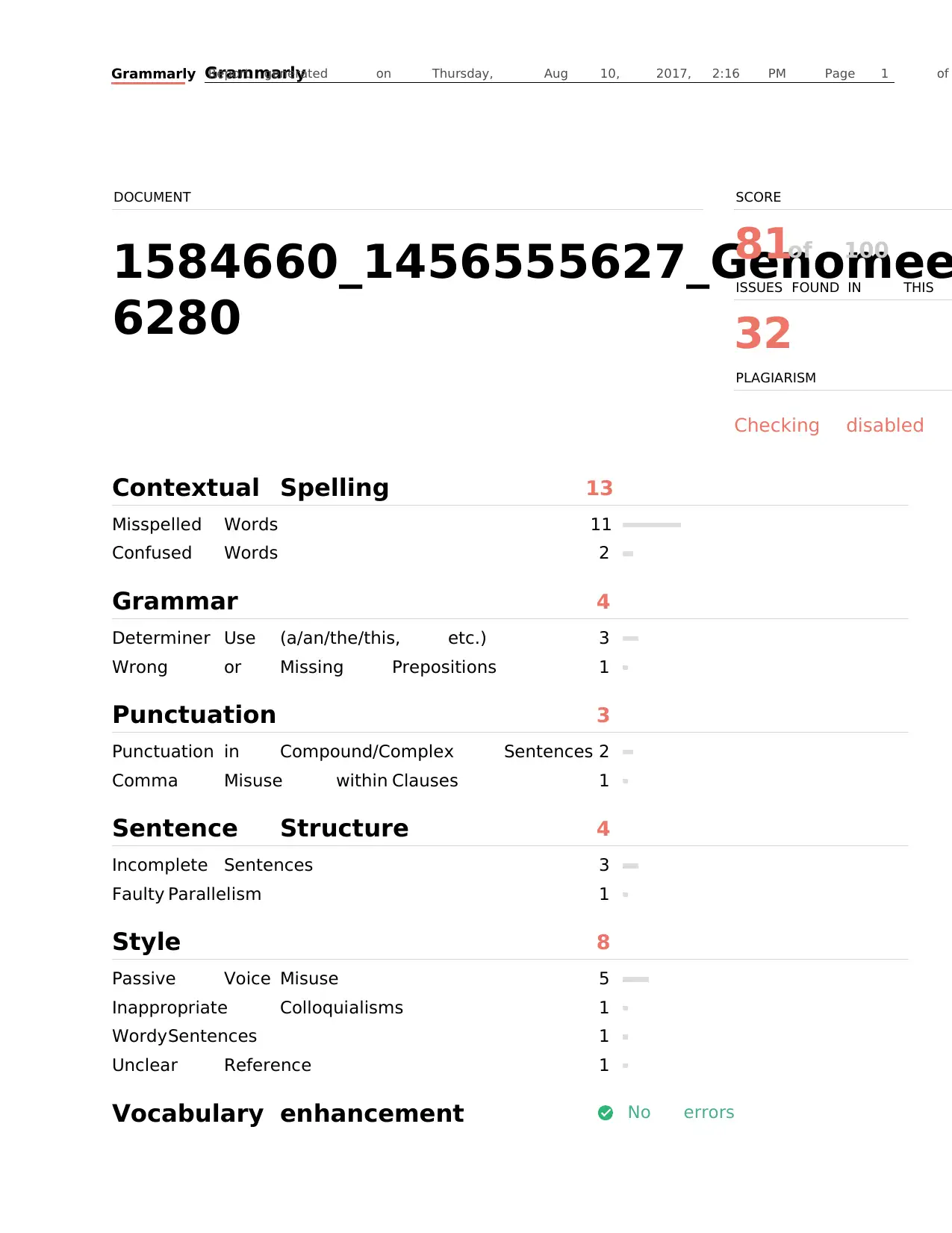
Grammarly GrammarlyReport generated on Thursday, Aug 10, 2017, 2:16 PM Page 1 of
11
2
3
1
2
1
3
1
5
1
1
1
DOCUMENT
1584660_1456555627_Genomee
6280
SCORE
81
ISSUES FOUND IN THIS
32
PLAGIARISM
Checking disabled
Contextual Spelling 13
Misspelled Words
Confused Words
Grammar 4
Determiner Use (a/an/the/this, etc.)
Wrong or Missing Prepositions
Punctuation 3
Punctuation in Compound/Complex Sentences
Comma Misuse within Clauses
Sentence Structure 4
Incomplete Sentences
Faulty Parallelism
Style 8
Passive Voice Misuse
Inappropriate Colloquialisms
WordySentences
Unclear Reference
Vocabulary enhancement
of 100
No errors
11
2
3
1
2
1
3
1
5
1
1
1
DOCUMENT
1584660_1456555627_Genomee
6280
SCORE
81
ISSUES FOUND IN THIS
32
PLAGIARISM
Checking disabled
Contextual Spelling 13
Misspelled Words
Confused Words
Grammar 4
Determiner Use (a/an/the/this, etc.)
Wrong or Missing Prepositions
Punctuation 3
Punctuation in Compound/Complex Sentences
Comma Misuse within Clauses
Sentence Structure 4
Incomplete Sentences
Faulty Parallelism
Style 8
Passive Voice Misuse
Inappropriate Colloquialisms
WordySentences
Unclear Reference
Vocabulary enhancement
of 100
No errors
Secure Best Marks with AI Grader
Need help grading? Try our AI Grader for instant feedback on your assignments.

Grammarly GrammarlyReport generated on Thursday, Aug 10, 2017, 2:16 PM Page 2 of
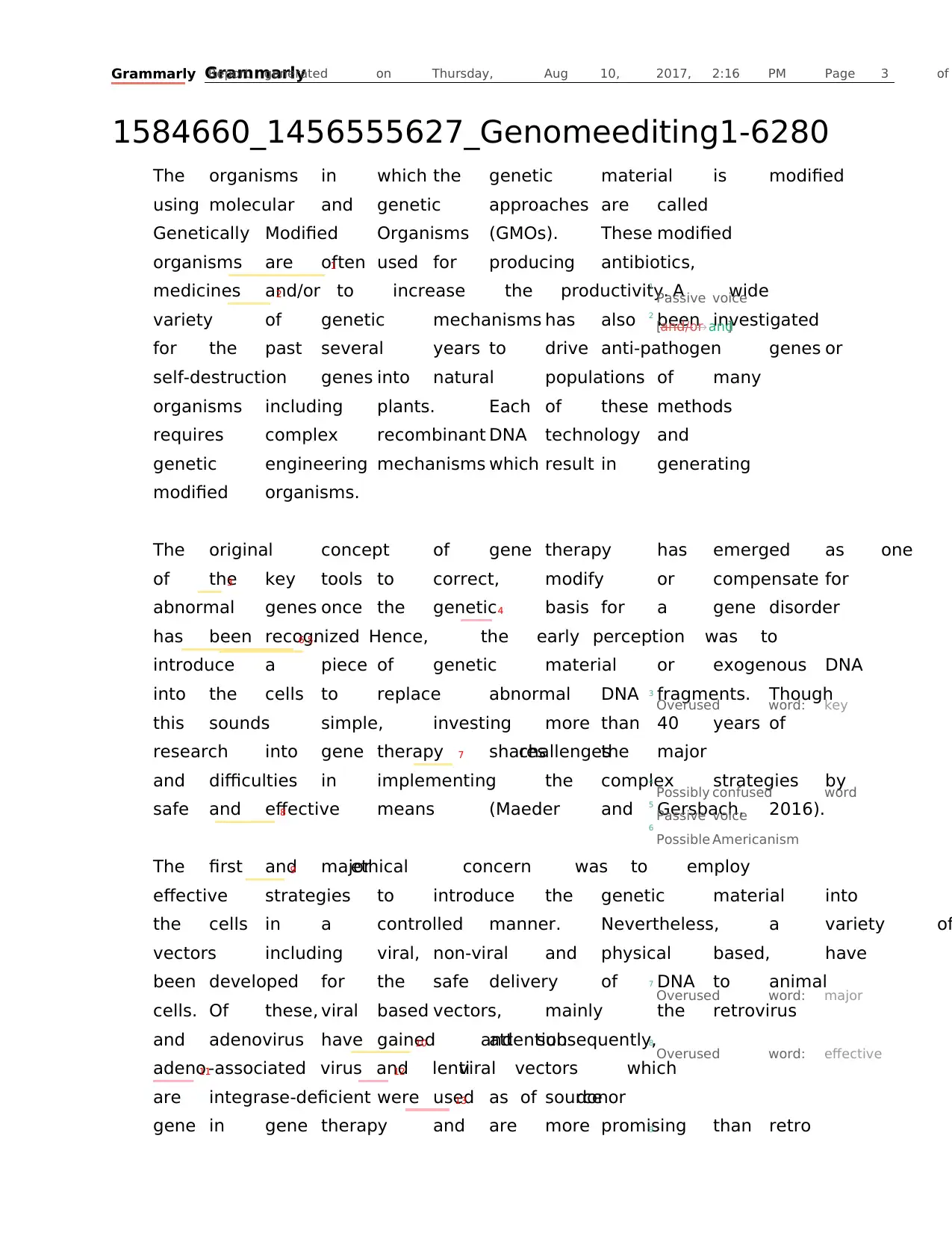
Grammarly GrammarlyReport generated on Thursday, Aug 10, 2017, 2:16 PM Page 3 of
1584660_1456555627_Genomeediting1-6280
The organisms in which the genetic material is modified
using molecular and genetic approaches are called
Genetically Modified Organisms (GMOs). These modified
organisms are often used for producing antibiotics,
medicines and/or to increase the productivity. A wide
variety of genetic mechanisms has also been investigated
for the past several years to drive anti-pathogen genes or
self-destruction genes into natural populations of many
organisms including plants. Each of these methods
requires complex recombinant DNA technology and
genetic engineering mechanisms which result in generating
modified organisms.
The original concept of gene therapy has emerged as one
of the key tools to correct, modify or compensate for
abnormal genes once the genetic basis for a gene disorder
has been recognized. Hence, the early perception was to
introduce a piece of genetic material or exogenous DNA
into the cells to replace abnormal DNA fragments. Though
this sounds simple, investing more than 40 years of
research into gene therapy shares the majorchallenges
and difficulties in implementing the complex strategies by
safe and effective means (Maeder and Gersbach, 2016).
The first and majorethical concern was to employ
effective strategies to introduce the genetic material into
the cells in a controlled manner. Nevertheless, a variety of
vectors including viral, non-viral and physical based, have
been developed for the safe delivery of DNA to animal
cells. Of these, viral based vectors, mainly the retrovirus
and adenovirus have gained attentionand subsequently,
adeno -associated virus and lentiviral vectors which
are integrase-deficient were used as sourceof donor
gene in gene therapy and are more promising than retro
1
2
3
4
6 5
7
8
9
10
11 12
13
1
Passive voice
2
[ ]
3
Overused word: key
4
Possibly confused word
5
Passive voice
6
Possible Americanism
7
Overused word: major
8
Overused word: effective
9
and/or and→
1584660_1456555627_Genomeediting1-6280
The organisms in which the genetic material is modified
using molecular and genetic approaches are called
Genetically Modified Organisms (GMOs). These modified
organisms are often used for producing antibiotics,
medicines and/or to increase the productivity. A wide
variety of genetic mechanisms has also been investigated
for the past several years to drive anti-pathogen genes or
self-destruction genes into natural populations of many
organisms including plants. Each of these methods
requires complex recombinant DNA technology and
genetic engineering mechanisms which result in generating
modified organisms.
The original concept of gene therapy has emerged as one
of the key tools to correct, modify or compensate for
abnormal genes once the genetic basis for a gene disorder
has been recognized. Hence, the early perception was to
introduce a piece of genetic material or exogenous DNA
into the cells to replace abnormal DNA fragments. Though
this sounds simple, investing more than 40 years of
research into gene therapy shares the majorchallenges
and difficulties in implementing the complex strategies by
safe and effective means (Maeder and Gersbach, 2016).
The first and majorethical concern was to employ
effective strategies to introduce the genetic material into
the cells in a controlled manner. Nevertheless, a variety of
vectors including viral, non-viral and physical based, have
been developed for the safe delivery of DNA to animal
cells. Of these, viral based vectors, mainly the retrovirus
and adenovirus have gained attentionand subsequently,
adeno -associated virus and lentiviral vectors which
are integrase-deficient were used as sourceof donor
gene in gene therapy and are more promising than retro
1
2
3
4
6 5
7
8
9
10
11 12
13
1
Passive voice
2
[ ]
3
Overused word: key
4
Possibly confused word
5
Passive voice
6
Possible Americanism
7
Overused word: major
8
Overused word: effective
9
and/or and→
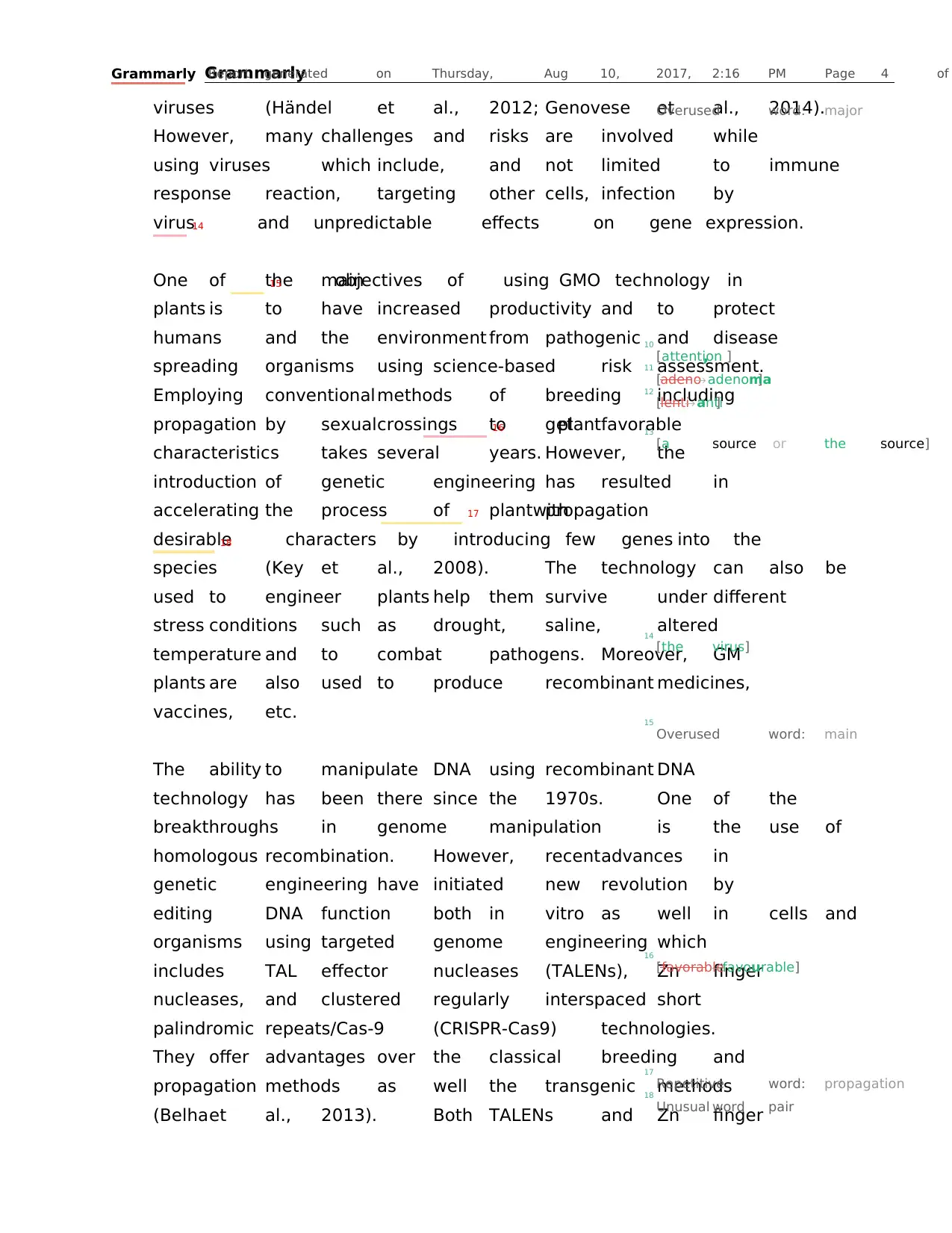
Grammarly GrammarlyReport generated on Thursday, Aug 10, 2017, 2:16 PM Page 4 of
viruses (Händel et al., 2012; Genovese et al., 2014).
However, many challenges and risks are involved while
using viruses which include, and not limited to immune
response reaction, targeting other cells, infection by
virus and unpredictable effects on gene expression.
One of the mainobjectives of using GMO technology in
plants is to have increased productivity and to protect
humans and the environment from pathogenic and disease
spreading organisms using science-based risk assessment.
Employing conventional methods of breeding including
propagation by sexualcrossings to get favorableplant
characteristics takes several years. However, the
introduction of genetic engineering has resulted in
accelerating the process of plant propagationwith
desirable characters by introducing few genes into the
species (Key et al., 2008). The technology can also be
used to engineer plants help them survive under different
stress conditions such as drought, saline, altered
temperature and to combat pathogens. Moreover, GM
plants are also used to produce recombinant medicines,
vaccines, etc.
The ability to manipulate DNA using recombinant DNA
technology has been there since the 1970s. One of the
breakthroughs in genome manipulation is the use of
homologous recombination. However, recentadvances in
genetic engineering have initiated new revolution by
editing DNA function both in vitro as well in cells and
organisms using targeted genome engineering which
includes TAL effector nucleases (TALENs), Zn finger
nucleases, and clustered regularly interspaced short
palindromic repeats/Cas-9 (CRISPR-Cas9) technologies.
They offer advantages over the classical breeding and
propagation methods as well the transgenic methods
(Belhaet al., 2013). Both TALENs and Zn finger
14
15
16
17
18
Overused word: major
10
[attention ],
11
[ ]
12
[ ]
13
[a source or the source]
14
[the virus]
15
Overused word: main
16
[favorablefavourable]→
17
Repetitive word: propagation
18
Unusual word pair
adeno adenoma→
lenti anti→
viruses (Händel et al., 2012; Genovese et al., 2014).
However, many challenges and risks are involved while
using viruses which include, and not limited to immune
response reaction, targeting other cells, infection by
virus and unpredictable effects on gene expression.
One of the mainobjectives of using GMO technology in
plants is to have increased productivity and to protect
humans and the environment from pathogenic and disease
spreading organisms using science-based risk assessment.
Employing conventional methods of breeding including
propagation by sexualcrossings to get favorableplant
characteristics takes several years. However, the
introduction of genetic engineering has resulted in
accelerating the process of plant propagationwith
desirable characters by introducing few genes into the
species (Key et al., 2008). The technology can also be
used to engineer plants help them survive under different
stress conditions such as drought, saline, altered
temperature and to combat pathogens. Moreover, GM
plants are also used to produce recombinant medicines,
vaccines, etc.
The ability to manipulate DNA using recombinant DNA
technology has been there since the 1970s. One of the
breakthroughs in genome manipulation is the use of
homologous recombination. However, recentadvances in
genetic engineering have initiated new revolution by
editing DNA function both in vitro as well in cells and
organisms using targeted genome engineering which
includes TAL effector nucleases (TALENs), Zn finger
nucleases, and clustered regularly interspaced short
palindromic repeats/Cas-9 (CRISPR-Cas9) technologies.
They offer advantages over the classical breeding and
propagation methods as well the transgenic methods
(Belhaet al., 2013). Both TALENs and Zn finger
14
15
16
17
18
Overused word: major
10
[attention ],
11
[ ]
12
[ ]
13
[a source or the source]
14
[the virus]
15
Overused word: main
16
[favorablefavourable]→
17
Repetitive word: propagation
18
Unusual word pair
adeno adenoma→
lenti anti→
Secure Best Marks with AI Grader
Need help grading? Try our AI Grader for instant feedback on your assignments.
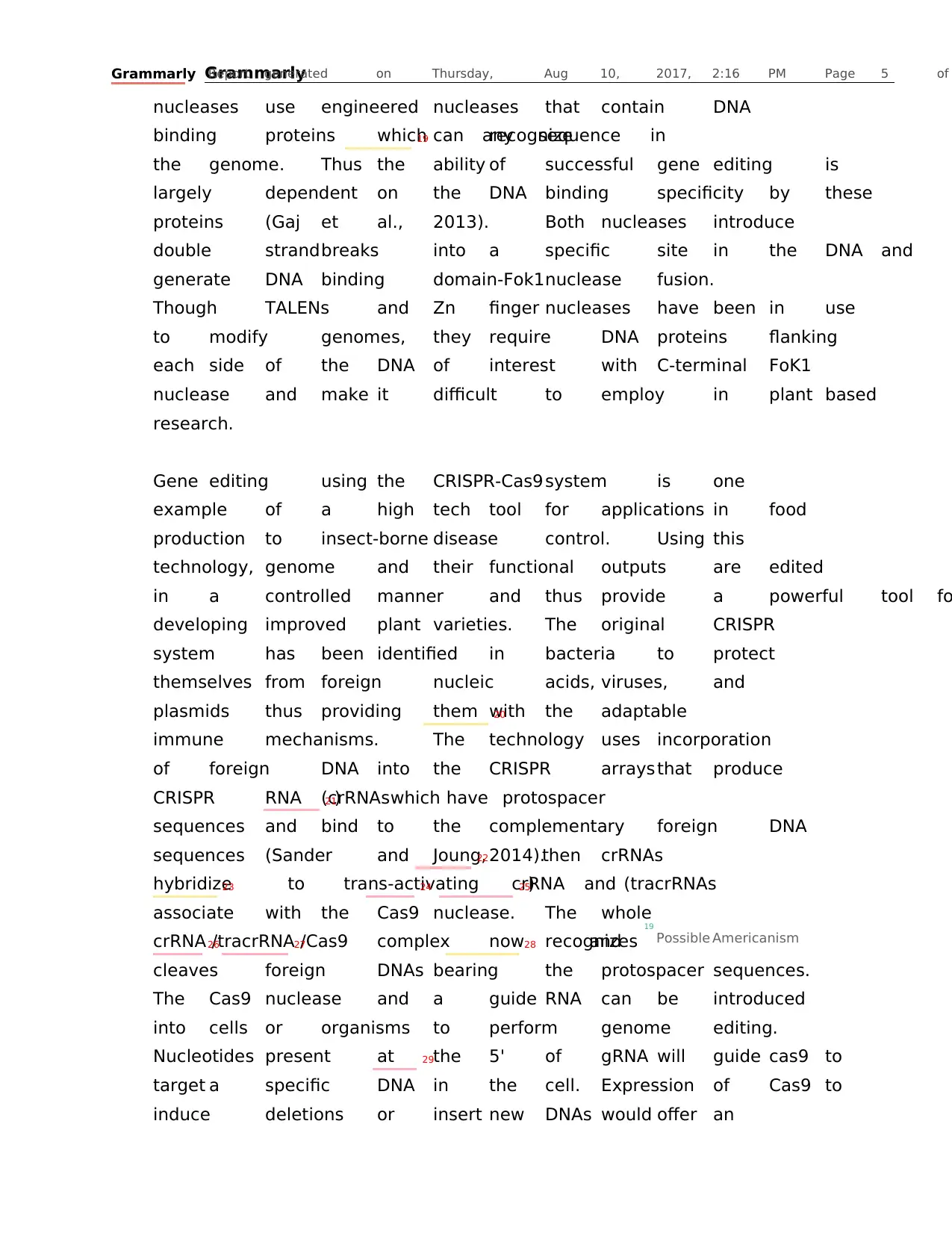
Grammarly GrammarlyReport generated on Thursday, Aug 10, 2017, 2:16 PM Page 5 of
nucleases use engineered nucleases that contain DNA
binding proteins which can recognizeany sequence in
the genome. Thus the ability of successful gene editing is
largely dependent on the DNA binding specificity by these
proteins (Gaj et al., 2013). Both nucleases introduce
double strandbreaks into a specific site in the DNA and
generate DNA binding domain-Fok1nuclease fusion.
Though TALENs and Zn finger nucleases have been in use
to modify genomes, they require DNA proteins flanking
each side of the DNA of interest with C-terminal FoK1
nuclease and make it difficult to employ in plant based
research.
Gene editing using the CRISPR-Cas9 system is one
example of a high tech tool for applications in food
production to insect-borne disease control. Using this
technology, genome and their functional outputs are edited
in a controlled manner and thus provide a powerful tool fo
developing improved plant varieties. The original CRISPR
system has been identified in bacteria to protect
themselves from foreign nucleic acids, viruses, and
plasmids thus providing them with the adaptable
immune mechanisms. The technology uses incorporation
of foreign DNA into the CRISPR arrays that produce
CRISPR RNA (crRNAs) which have protospacer
sequences and bind to the complementary foreign DNA
sequences (Sander and Joung, 2014). crRNAsthen
hybridize to trans-activating crRNA (tracrRNAs) and
associate with the Cas9 nuclease. The whole
crRNA /tracrRNA /Cas9 complex now recognizesand
cleaves foreign DNAs bearing the protospacer sequences.
The Cas9 nuclease and a guide RNA can be introduced
into cells or organisms to perform genome editing.
Nucleotides present at the 5' of gRNA will guide cas9 to
target a specific DNA in the cell. Expression of Cas9 to
induce deletions or insert new DNAs would offer an
19
20
21
22
23 24 25
26 27 28
29
19
Possible Americanism
nucleases use engineered nucleases that contain DNA
binding proteins which can recognizeany sequence in
the genome. Thus the ability of successful gene editing is
largely dependent on the DNA binding specificity by these
proteins (Gaj et al., 2013). Both nucleases introduce
double strandbreaks into a specific site in the DNA and
generate DNA binding domain-Fok1nuclease fusion.
Though TALENs and Zn finger nucleases have been in use
to modify genomes, they require DNA proteins flanking
each side of the DNA of interest with C-terminal FoK1
nuclease and make it difficult to employ in plant based
research.
Gene editing using the CRISPR-Cas9 system is one
example of a high tech tool for applications in food
production to insect-borne disease control. Using this
technology, genome and their functional outputs are edited
in a controlled manner and thus provide a powerful tool fo
developing improved plant varieties. The original CRISPR
system has been identified in bacteria to protect
themselves from foreign nucleic acids, viruses, and
plasmids thus providing them with the adaptable
immune mechanisms. The technology uses incorporation
of foreign DNA into the CRISPR arrays that produce
CRISPR RNA (crRNAs) which have protospacer
sequences and bind to the complementary foreign DNA
sequences (Sander and Joung, 2014). crRNAsthen
hybridize to trans-activating crRNA (tracrRNAs) and
associate with the Cas9 nuclease. The whole
crRNA /tracrRNA /Cas9 complex now recognizesand
cleaves foreign DNAs bearing the protospacer sequences.
The Cas9 nuclease and a guide RNA can be introduced
into cells or organisms to perform genome editing.
Nucleotides present at the 5' of gRNA will guide cas9 to
target a specific DNA in the cell. Expression of Cas9 to
induce deletions or insert new DNAs would offer an
19
20
21
22
23 24 25
26 27 28
29
19
Possible Americanism
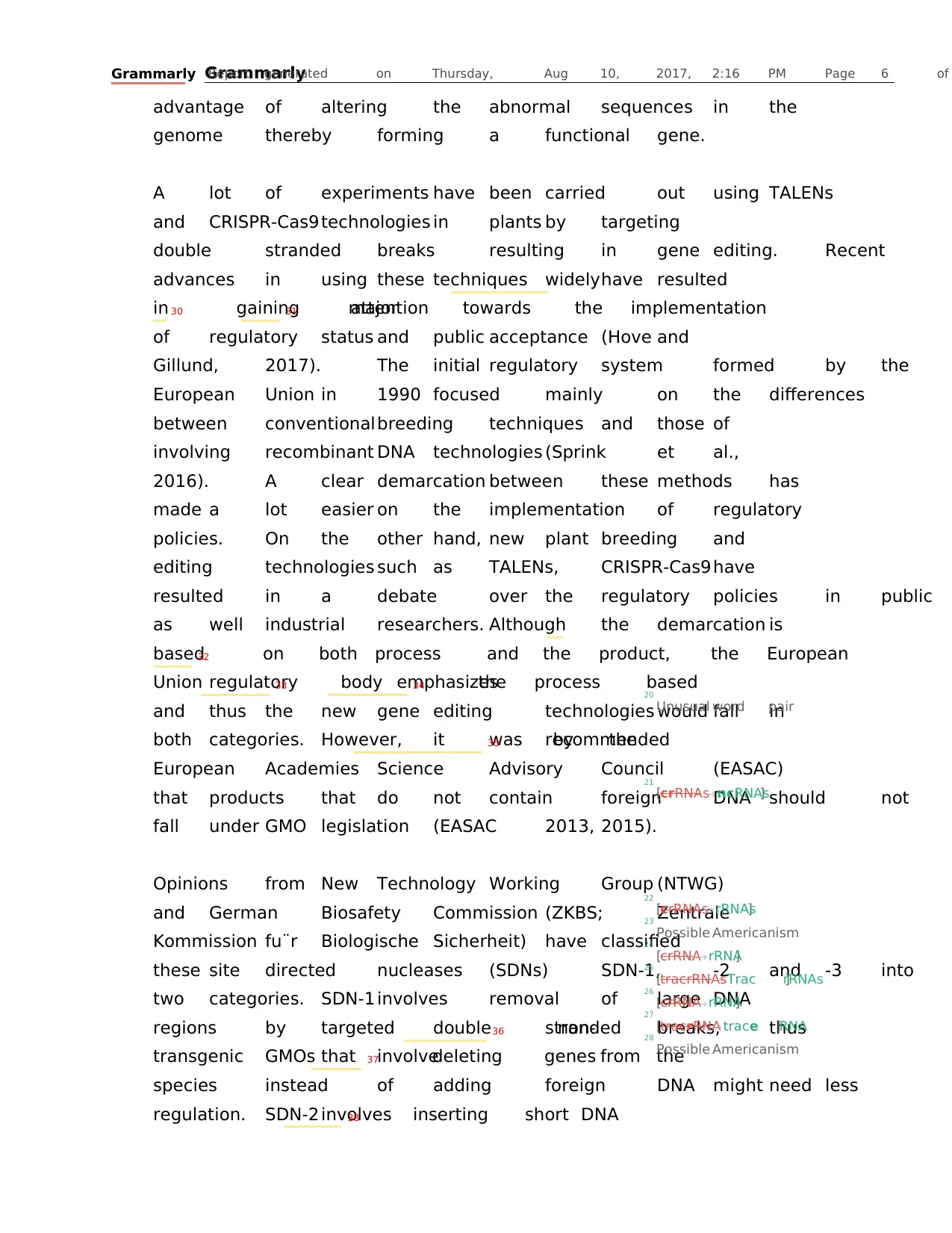
Grammarly GrammarlyReport generated on Thursday, Aug 10, 2017, 2:16 PM Page 6 of
advantage of altering the abnormal sequences in the
genome thereby forming a functional gene.
A lot of experiments have been carried out using TALENs
and CRISPR-Cas9 technologies in plants by targeting
double stranded breaks resulting in gene editing. Recent
advances in using these techniques widelyhave resulted
in gaining majorattention towards the implementation
of regulatory status and public acceptance (Hove and
Gillund, 2017). The initial regulatory system formed by the
European Union in 1990 focused mainly on the differences
between conventional breeding techniques and those of
involving recombinant DNA technologies (Sprink et al.,
2016). A clear demarcation between these methods has
made a lot easier on the implementation of regulatory
policies. On the other hand, new plant breeding and
editing technologies such as TALENs, CRISPR-Cas9 have
resulted in a debate over the regulatory policies in public
as well industrial researchers. Although the demarcation is
based on both process and the product, the European
Union regulatory body emphasizesthe process based
and thus the new gene editing technologies would fall in
both categories. However, it was recommendedby the
European Academies Science Advisory Council (EASAC)
that products that do not contain foreign DNA should not
fall under GMO legislation (EASAC 2013, 2015).
Opinions from New Technology Working Group (NTWG)
and German Biosafety Commission (ZKBS; Zentrale
Kommission fu¨r Biologische Sicherheit) have classified
these site directed nucleases (SDNs) SDN-1, -2 and -3 into
two categories. SDN-1 involves removal of large DNA
regions by targeted double stranded breaks, thusnon-
transgenic GMOs that involvedeleting genes from the
species instead of adding foreign DNA might need less
regulation. SDN-2 involves inserting short DNA
30 31
32
33 34
35
36
37
38
20
Unusual word pair
21
[ ]
22
[ ]
23
Possible Americanism
24
[ ]
25
[ ]
26
[ ]
27
[ ]
28
Possible Americanism
crRNAs ncRNAs→
crRNAs rRNAs→
crRNA rRNA→
tracrRNAsTrac rRNAs→
crRNA rRNA→
tracrRNA trace RNA→
advantage of altering the abnormal sequences in the
genome thereby forming a functional gene.
A lot of experiments have been carried out using TALENs
and CRISPR-Cas9 technologies in plants by targeting
double stranded breaks resulting in gene editing. Recent
advances in using these techniques widelyhave resulted
in gaining majorattention towards the implementation
of regulatory status and public acceptance (Hove and
Gillund, 2017). The initial regulatory system formed by the
European Union in 1990 focused mainly on the differences
between conventional breeding techniques and those of
involving recombinant DNA technologies (Sprink et al.,
2016). A clear demarcation between these methods has
made a lot easier on the implementation of regulatory
policies. On the other hand, new plant breeding and
editing technologies such as TALENs, CRISPR-Cas9 have
resulted in a debate over the regulatory policies in public
as well industrial researchers. Although the demarcation is
based on both process and the product, the European
Union regulatory body emphasizesthe process based
and thus the new gene editing technologies would fall in
both categories. However, it was recommendedby the
European Academies Science Advisory Council (EASAC)
that products that do not contain foreign DNA should not
fall under GMO legislation (EASAC 2013, 2015).
Opinions from New Technology Working Group (NTWG)
and German Biosafety Commission (ZKBS; Zentrale
Kommission fu¨r Biologische Sicherheit) have classified
these site directed nucleases (SDNs) SDN-1, -2 and -3 into
two categories. SDN-1 involves removal of large DNA
regions by targeted double stranded breaks, thusnon-
transgenic GMOs that involvedeleting genes from the
species instead of adding foreign DNA might need less
regulation. SDN-2 involves inserting short DNA
30 31
32
33 34
35
36
37
38
20
Unusual word pair
21
[ ]
22
[ ]
23
Possible Americanism
24
[ ]
25
[ ]
26
[ ]
27
[ ]
28
Possible Americanism
crRNAs ncRNAs→
crRNAs rRNAs→
crRNA rRNA→
tracrRNAsTrac rRNAs→
crRNA rRNA→
tracrRNA trace RNA→
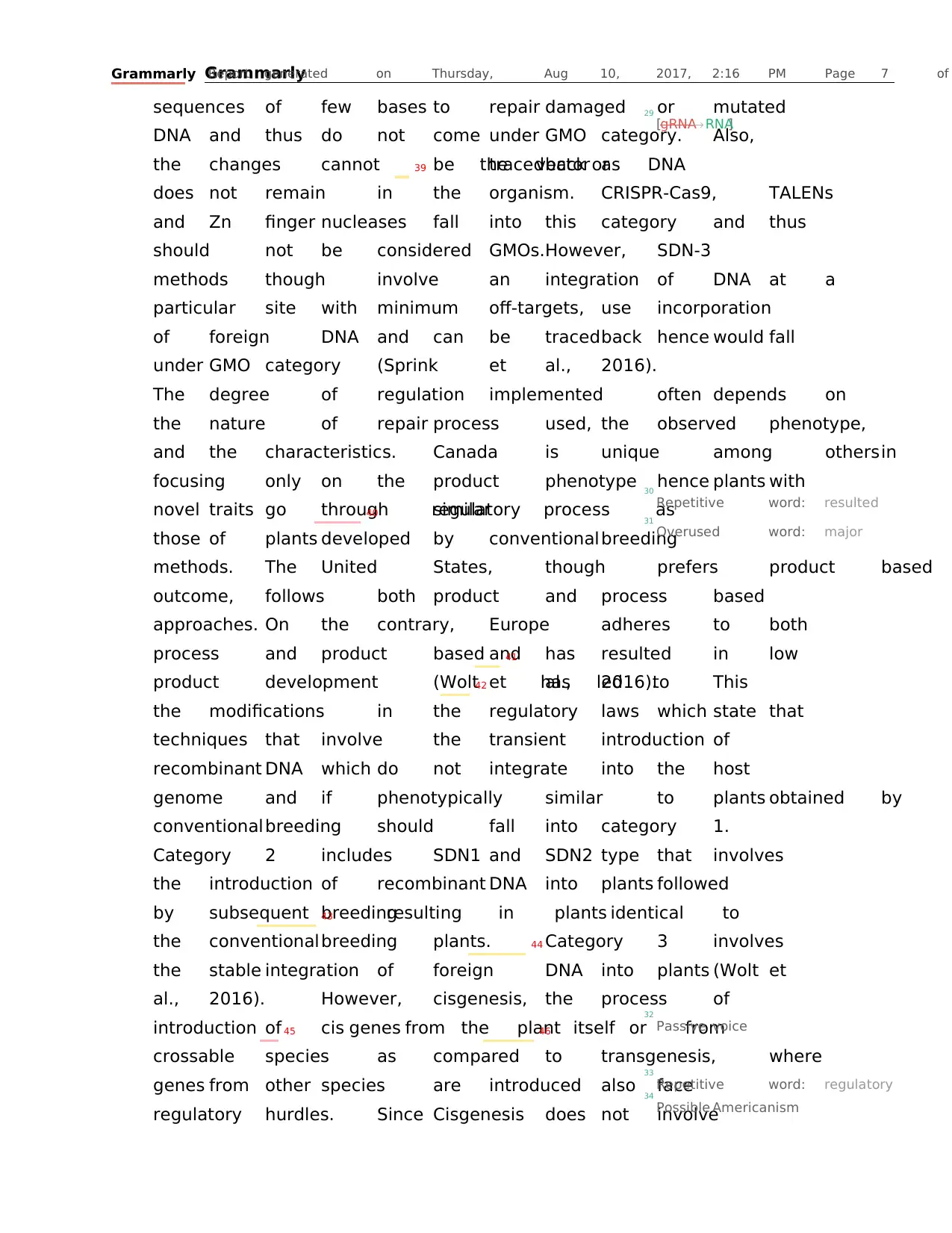
Grammarly GrammarlyReport generated on Thursday, Aug 10, 2017, 2:16 PM Page 7 of
sequences of few bases to repair damaged or mutated
DNA and thus do not come under GMO category. Also,
the changes cannot be tracedback asthe vectoror DNA
does not remain in the organism. CRISPR-Cas9, TALENs
and Zn finger nucleases fall into this category and thus
should not be considered GMOs.However, SDN-3
methods though involve an integration of DNA at a
particular site with minimum off-targets, use incorporation
of foreign DNA and can be tracedback hence would fall
under GMO category (Sprink et al., 2016).
The degree of regulation implemented often depends on
the nature of repair process used, the observed phenotype,
and the characteristics. Canada is unique among othersin
focusing only on the product phenotype hence plants with
novel traits go through similarregulatory process as
those of plants developed by conventional breeding
methods. The United States, though prefers product based
outcome, follows both product and process based
approaches. On the contrary, Europe adheres to both
process and product based and has resulted in low
product development (Wolt et al., 2016). Thishas led to
the modifications in the regulatory laws which state that
techniques that involve the transient introduction of
recombinant DNA which do not integrate into the host
genome and if phenotypically similar to plants obtained by
conventional breeding should fall into category 1.
Category 2 includes SDN1 and SDN2 type that involves
the introduction of recombinant DNA into plants followed
by subsequent breedingresulting in plants identical to
the conventional breeding plants. Category 3 involves
the stable integration of foreign DNA into plants (Wolt et
al., 2016). However, cisgenesis, the process of
introduction of cis genes from the plant itself or from
crossable species as compared to transgenesis, where
genes from other species are introduced also face
regulatory hurdles. Since Cisgenesis does not involve
39
40
41
42
43
44
45 46
29
[ ]
30
Repetitive word: resulted
31
Overused word: major
32
Passive voice
33
Repetitive word: regulatory
34
Possible Americanism
gRNA RNA→
sequences of few bases to repair damaged or mutated
DNA and thus do not come under GMO category. Also,
the changes cannot be tracedback asthe vectoror DNA
does not remain in the organism. CRISPR-Cas9, TALENs
and Zn finger nucleases fall into this category and thus
should not be considered GMOs.However, SDN-3
methods though involve an integration of DNA at a
particular site with minimum off-targets, use incorporation
of foreign DNA and can be tracedback hence would fall
under GMO category (Sprink et al., 2016).
The degree of regulation implemented often depends on
the nature of repair process used, the observed phenotype,
and the characteristics. Canada is unique among othersin
focusing only on the product phenotype hence plants with
novel traits go through similarregulatory process as
those of plants developed by conventional breeding
methods. The United States, though prefers product based
outcome, follows both product and process based
approaches. On the contrary, Europe adheres to both
process and product based and has resulted in low
product development (Wolt et al., 2016). Thishas led to
the modifications in the regulatory laws which state that
techniques that involve the transient introduction of
recombinant DNA which do not integrate into the host
genome and if phenotypically similar to plants obtained by
conventional breeding should fall into category 1.
Category 2 includes SDN1 and SDN2 type that involves
the introduction of recombinant DNA into plants followed
by subsequent breedingresulting in plants identical to
the conventional breeding plants. Category 3 involves
the stable integration of foreign DNA into plants (Wolt et
al., 2016). However, cisgenesis, the process of
introduction of cis genes from the plant itself or from
crossable species as compared to transgenesis, where
genes from other species are introduced also face
regulatory hurdles. Since Cisgenesis does not involve
39
40
41
42
43
44
45 46
29
[ ]
30
Repetitive word: resulted
31
Overused word: major
32
Passive voice
33
Repetitive word: regulatory
34
Possible Americanism
gRNA RNA→
Paraphrase This Document
Need a fresh take? Get an instant paraphrase of this document with our AI Paraphraser
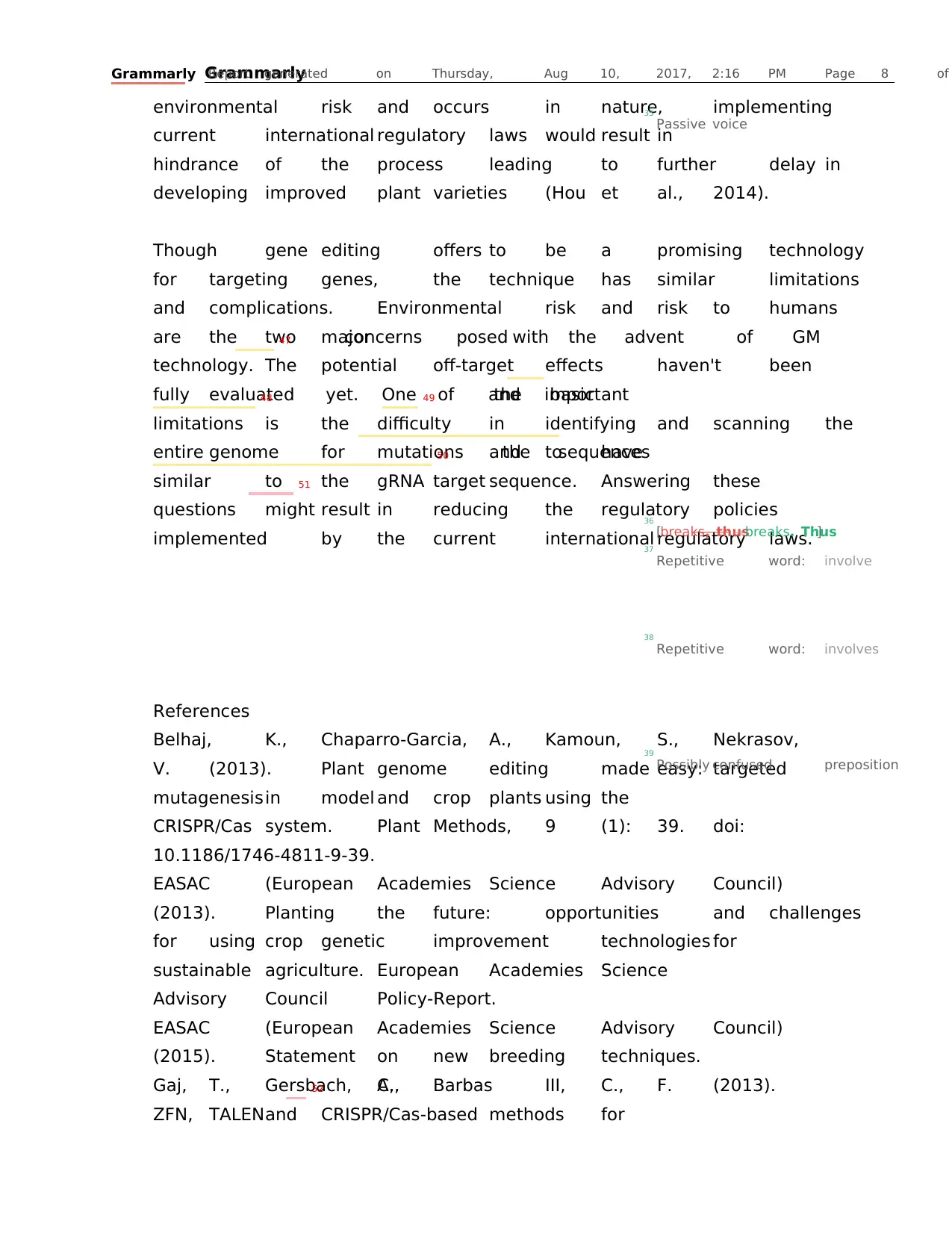
Grammarly GrammarlyReport generated on Thursday, Aug 10, 2017, 2:16 PM Page 8 of
environmental risk and occurs in nature, implementing
current international regulatory laws would result in
hindrance of the process leading to further delay in
developing improved plant varieties (Hou et al., 2014).
Though gene editing offers to be a promising technology
for targeting genes, the technique has similar limitations
and complications. Environmental risk and risk to humans
are the two majorconcerns posed with the advent of GM
technology. The potential off-target effects haven't been
fully evaluated yet. One of the basicand important
limitations is the difficulty in identifying and scanning the
entire genome for mutations and to havethe sequences
similar to the gRNA target sequence. Answering these
questions might result in reducing the regulatory policies
implemented by the current international regulatory laws.
References
Belhaj, K., Chaparro-Garcia, A., Kamoun, S., Nekrasov,
V. (2013). Plant genome editing made easy: targeted
mutagenesisin model and crop plants using the
CRISPR/Cas system. Plant Methods, 9 (1): 39. doi:
10.1186/1746-4811-9-39.
EASAC (European Academies Science Advisory Council)
(2013). Planting the future: opportunities and challenges
for using crop genetic improvement technologies for
sustainable agriculture. European Academies Science
Advisory Council Policy-Report.
EASAC (European Academies Science Advisory Council)
(2015). Statement on new breeding techniques.
Gaj, T., Gersbach, C,.A., Barbas III, C., F. (2013).
ZFN, TALENand CRISPR/Cas-based methods for
47
48 49
50
51
52
35
Passive voice
36
[ ]
37
Repetitive word: involve
38
Repetitive word: involves
39
Possibly confused preposition
breaks, thusbreaks. Thus→
environmental risk and occurs in nature, implementing
current international regulatory laws would result in
hindrance of the process leading to further delay in
developing improved plant varieties (Hou et al., 2014).
Though gene editing offers to be a promising technology
for targeting genes, the technique has similar limitations
and complications. Environmental risk and risk to humans
are the two majorconcerns posed with the advent of GM
technology. The potential off-target effects haven't been
fully evaluated yet. One of the basicand important
limitations is the difficulty in identifying and scanning the
entire genome for mutations and to havethe sequences
similar to the gRNA target sequence. Answering these
questions might result in reducing the regulatory policies
implemented by the current international regulatory laws.
References
Belhaj, K., Chaparro-Garcia, A., Kamoun, S., Nekrasov,
V. (2013). Plant genome editing made easy: targeted
mutagenesisin model and crop plants using the
CRISPR/Cas system. Plant Methods, 9 (1): 39. doi:
10.1186/1746-4811-9-39.
EASAC (European Academies Science Advisory Council)
(2013). Planting the future: opportunities and challenges
for using crop genetic improvement technologies for
sustainable agriculture. European Academies Science
Advisory Council Policy-Report.
EASAC (European Academies Science Advisory Council)
(2015). Statement on new breeding techniques.
Gaj, T., Gersbach, C,.A., Barbas III, C., F. (2013).
ZFN, TALENand CRISPR/Cas-based methods for
47
48 49
50
51
52
35
Passive voice
36
[ ]
37
Repetitive word: involve
38
Repetitive word: involves
39
Possibly confused preposition
breaks, thusbreaks. Thus→
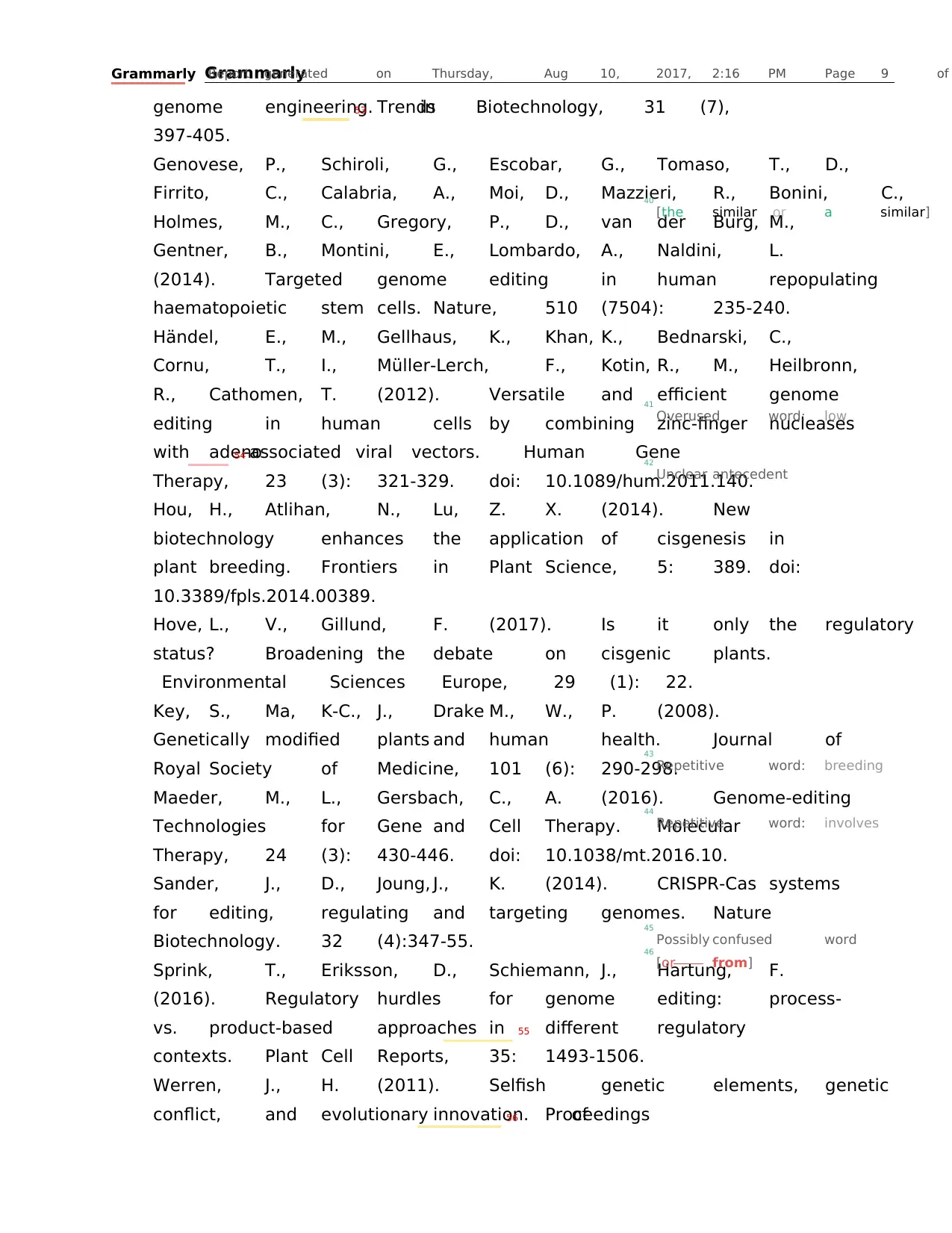
Grammarly GrammarlyReport generated on Thursday, Aug 10, 2017, 2:16 PM Page 9 of
genome engineering. Trendsin Biotechnology, 31 (7),
397-405.
Genovese, P., Schiroli, G., Escobar, G., Tomaso, T., D.,
Firrito, C., Calabria, A., Moi, D., Mazzieri, R., Bonini, C.,
Holmes, M., C., Gregory, P., D., van der Burg, M.,
Gentner, B., Montini, E., Lombardo, A., Naldini, L.
(2014). Targeted genome editing in human repopulating
haematopoietic stem cells. Nature, 510 (7504): 235-240.
Händel, E., M., Gellhaus, K., Khan, K., Bednarski, C.,
Cornu, T., I., Müller-Lerch, F., Kotin, R., M., Heilbronn,
R., Cathomen, T. (2012). Versatile and efficient genome
editing in human cells by combining zinc-finger nucleases
with adeno-associated viral vectors. Human Gene
Therapy, 23 (3): 321-329. doi: 10.1089/hum.2011.140.
Hou, H., Atlihan, N., Lu, Z. X. (2014). New
biotechnology enhances the application of cisgenesis in
plant breeding. Frontiers in Plant Science, 5: 389. doi:
10.3389/fpls.2014.00389.
Hove, L., V., Gillund, F. (2017). Is it only the regulatory
status? Broadening the debate on cisgenic plants.
Environmental Sciences Europe, 29 (1): 22.
Key, S., Ma, K-C., J., Drake M., W., P. (2008).
Genetically modified plants and human health. Journal of
Royal Society of Medicine, 101 (6): 290-298.
Maeder, M., L., Gersbach, C., A. (2016). Genome-editing
Technologies for Gene and Cell Therapy. Molecular
Therapy, 24 (3): 430-446. doi: 10.1038/mt.2016.10.
Sander, J., D., Joung, J., K. (2014). CRISPR-Cas systems
for editing, regulating and targeting genomes. Nature
Biotechnology. 32 (4):347-55.
Sprink, T., Eriksson, D., Schiemann, J., Hartung, F.
(2016). Regulatory hurdles for genome editing: process-
vs. product-based approaches in different regulatory
contexts. Plant Cell Reports, 35: 1493-1506.
Werren, J., H. (2011). Selfish genetic elements, genetic
conflict, and evolutionary innovation. Proceedingsof
53
54
55
56
40
[the similar or a similar]
41
Overused word: low
42
Unclear antecedent
43
Repetitive word: breeding
44
Repetitive word: involves
45
Possibly confused word
46
[or from]
genome engineering. Trendsin Biotechnology, 31 (7),
397-405.
Genovese, P., Schiroli, G., Escobar, G., Tomaso, T., D.,
Firrito, C., Calabria, A., Moi, D., Mazzieri, R., Bonini, C.,
Holmes, M., C., Gregory, P., D., van der Burg, M.,
Gentner, B., Montini, E., Lombardo, A., Naldini, L.
(2014). Targeted genome editing in human repopulating
haematopoietic stem cells. Nature, 510 (7504): 235-240.
Händel, E., M., Gellhaus, K., Khan, K., Bednarski, C.,
Cornu, T., I., Müller-Lerch, F., Kotin, R., M., Heilbronn,
R., Cathomen, T. (2012). Versatile and efficient genome
editing in human cells by combining zinc-finger nucleases
with adeno-associated viral vectors. Human Gene
Therapy, 23 (3): 321-329. doi: 10.1089/hum.2011.140.
Hou, H., Atlihan, N., Lu, Z. X. (2014). New
biotechnology enhances the application of cisgenesis in
plant breeding. Frontiers in Plant Science, 5: 389. doi:
10.3389/fpls.2014.00389.
Hove, L., V., Gillund, F. (2017). Is it only the regulatory
status? Broadening the debate on cisgenic plants.
Environmental Sciences Europe, 29 (1): 22.
Key, S., Ma, K-C., J., Drake M., W., P. (2008).
Genetically modified plants and human health. Journal of
Royal Society of Medicine, 101 (6): 290-298.
Maeder, M., L., Gersbach, C., A. (2016). Genome-editing
Technologies for Gene and Cell Therapy. Molecular
Therapy, 24 (3): 430-446. doi: 10.1038/mt.2016.10.
Sander, J., D., Joung, J., K. (2014). CRISPR-Cas systems
for editing, regulating and targeting genomes. Nature
Biotechnology. 32 (4):347-55.
Sprink, T., Eriksson, D., Schiemann, J., Hartung, F.
(2016). Regulatory hurdles for genome editing: process-
vs. product-based approaches in different regulatory
contexts. Plant Cell Reports, 35: 1493-1506.
Werren, J., H. (2011). Selfish genetic elements, genetic
conflict, and evolutionary innovation. Proceedingsof
53
54
55
56
40
[the similar or a similar]
41
Overused word: low
42
Unclear antecedent
43
Repetitive word: breeding
44
Repetitive word: involves
45
Possibly confused word
46
[or from]

Grammarly GrammarlyReport generated on Thursday, Aug 10, 2017, 2:16 PM Page 10 of
National Academy of Sciences. USA. 108 Suppl 2: 10863-
10870.
Wolt, J. D., Wang,K., Yang, B. (2016). The Regulatory
Status of Genome-edited Crops.Plant Biotechnology
Journal, 14: 510-518.
57
47
Overused word: major
48
Passive voice
49
Overused word: basic
50
Faulty parallelism
51
[ ]gRNA RNA→
National Academy of Sciences. USA. 108 Suppl 2: 10863-
10870.
Wolt, J. D., Wang,K., Yang, B. (2016). The Regulatory
Status of Genome-edited Crops.Plant Biotechnology
Journal, 14: 510-518.
57
47
Overused word: major
48
Passive voice
49
Overused word: basic
50
Faulty parallelism
51
[ ]gRNA RNA→
Secure Best Marks with AI Grader
Need help grading? Try our AI Grader for instant feedback on your assignments.

Grammarly GrammarlyReport generated on Thursday, Aug 10, 2017, 2:16 PM Page 11 of
52
[ ]
53
Missing verb
54
[ ]
C C,. → ,
adeno adenoma→
52
[ ]
53
Missing verb
54
[ ]
C C,. → ,
adeno adenoma→

Grammarly GrammarlyReport generated on Thursday, Aug 10, 2017, 2:16 PM Page 12 of
55
Repetitive word: regulatory
56
Missing verb
57
Missing verb
55
Repetitive word: regulatory
56
Missing verb
57
Missing verb
1 out of 12
Your All-in-One AI-Powered Toolkit for Academic Success.
+13062052269
info@desklib.com
Available 24*7 on WhatsApp / Email
![[object Object]](/_next/static/media/star-bottom.7253800d.svg)
Unlock your academic potential
© 2024 | Zucol Services PVT LTD | All rights reserved.

